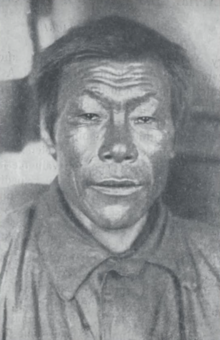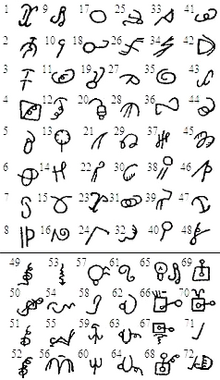Tenevil
This article needs additional citations for verification. (February 2015) |


Tenevil (
Around 1927 or 1928 he independently invented a writing system for the
Tenevil also developed symbols for numerals, using the base 20 counting system of the Chukchi language. To date, approximately 1,000 basic elements of the Tenevil writing system have been identified.
The emergence of the Tenevil Script is particularly remarkable given the rarity of isolate scripts. Tenevil's accomplishments provided invaluable insights to the field of

The sources and prototype of the Tenevil writing system are unknown. Taking into consideration the isolation of Chukotka from the regional centres of civilization, it could be considered a localized creative initiative of a lone genius. It is possible the writing system is influenced by the decorations on
Tenevil passed away sometime in the early 1940s. His proposed writing system, while innovative, did not gain widespread acceptance.[2] The lack of adoption can be attributed to local Chukchi efforts to resist Russification, which encompassed both cultural and linguistic aspects. Consequently, those among the Chukchi community who were inclined towards adopting a writing system predominantly chose the Cyrillic script over Tenevil's system.
In 1945, one or two years after Tenevil's death, the artist and art historian
The Chukchi writer Yuri Rytkheu dedicated his 1969 novel A Dream in Polar Fog to Tenevil.[1]
See also
References
- ^ a b c "Chukotskoye pis'mo: Samaya severnaya pis'mennost' mira" Чукотское письмо: Самая северная письменность мира [Chukchi letters: The northernmost written language in the world]. Rbardalzo (in Russian). Archived from the original on 5 December 2023.
- ^ Harbsmeier 1995, p. 256.
- ISBN 978-5-88431-271-5.
Bibliography
- Harbsmeier, Michael (1995). "Inventions of writing". In ISBN 0-203-99003-X.
